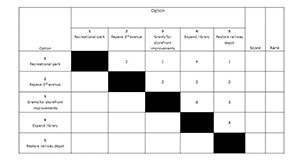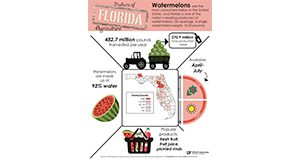Social Exchange Theory (SET) is based on the principle that human behavior is an exchange of rewards between people. This three-page fact sheet explains how it can be applied to Extension programming to promote clientele participation in programs and a commitment to changing their behaviors. Written by Amanda D. Ali and Laura A. Warner and published by the Department of Agricultural Education and Communication.
http://edis.ifas.ufl.edu/wc280
Tag: Planning and Evaluating Programs
Consultation Forms for Walk-In Clientele and Landscape Site Visits
This eight-page fact sheet contains forms for horticulture Extension agents and staff to use during walk-in consultations and/or on-site consultations related to plant identification, problem diagnosis, and cultural advice. The forms are available as fillable PDFs. Written by Amanda D. Ali, Laura A. Warner, Sydney Park Brown, Susan Haddock, and Laurie Albrecht and published by the Department of Agricultural Education and Communication.
http://edis.ifas.ufl.edu/wc277
Matrix Ranking: A Tool for Decision-Making and Prioritization
Matrix ranking is an activity used to analyze and prioritize information. Extension professionals often work with community groups who may benefit from this type of analysis. This four-page fact sheet explains how Extension professionals can use matrix ranking to facilitate prioritization and decision-making. Written by Keegan Gay, Eric Stubbs, and Sebastian Galindo-Gonzalez and published by the Department of Agricultural Education and Communication.
http://edis.ifas.ufl.edu/wc239
Promoting Ag Awareness through Commodity Fact Sheets
Increasing public awareness of Florida agriculture is a vital step in motivating the public to support agriculture. A basic understanding of Florida’s agricultural products, their impacts on the economy and the environment, and their availability contributes to Extension’s mission to sustain and enhance quality of life. This three-page publication outlines a series of fact sheets with infographics related to specific Florida agricultural commodities. These fact sheets are intended to be visually appealing while presenting an overview of the commodity and its role in Florida agriculture. Written by Kathryn A. Stofer, Jessica Sullivan, Joy Rumble, and Libbie Johnson and published by the Department of Agricultural Education and Communication.
http://edis.ifas.ufl.edu/wc253
Identifying Gaps between Importance and Satisfaction to Identify Extension Clients' Needs
The third document in a series of three about using Importance-performance analyiss to prioritize Extension resources, this three-page article covers gap analysis as a means to understand a client's perceptions and rank Extension priorities. Gap analysis using IPA is an innovative and useful approach for Extension educators to conduct needs assessments and to evaluate programs. Written by Anil Kumar Chaudhary and Laura A. Warner and published by the Department of Agricultural Education and Communication.
http://edis.ifas.ufl.edu/wc252
Visually Plotting Importance and Satisfaction to Identify Extension Clients' Needs
The second document in a series of three about using importance-performance analysis to prioritize Extension resources, this four-page article covers how to collect data and use them to generate visual plots. IPA data plots are attractive and easy-to-understand visual maps that display importance and satisfaction scores for certain attributes. Written by Anil Kumar Chaudhary and Laura A. Warner and published by the Department of Agricultural Education and Communication.
http://edis.ifas.ufl.edu/wc251
Prioritizing Extension Resources Using Perceived Importance and Satisfaction: An Underutilized Approach
This is the first article in a series of three on using Importance-performance analysis to prioritize Extension resources. Importance-performance analysis, or IPA, measure how people feel about certain chracteristics of a place, issue, or program. Extension professionals can use IPA to make decisions and prioritize resources by understanding how clients rate the importance of and satisfaction with specific attributes of a program or facility. This three-page fact sheet explains IPA and how to use it. Written by Laura A. Warner and Anil Jumar Chaudhary and published by the Department of Agricultural Education and Communication.
http://edis.ifas.ufl.edu/wc250
Get SMART: Improve Your Extension Objectives

SMART Objectives assist educators and program planners in developing strong objectives that are Specific, Measurable, Achievable, Relevant and Time-bound. This 3-page fact sheet was written by David C. Diehl and Sebastian Galindo-Gonzalez. Published by the UF Department of Family Youth and Community Sciences, June 2012 and revised September 2015.
http://edis.ifas.ufl.edu/fy1327
Introduction to Social Network Research: General Introduction and Major Terminology
 Social networks play an important role in the functioning of society and have an important effect on the actions of an individual or organization. It is very important for Extension educators to understand the networks of their clientele in order to perform better and develop more impactful Extension programming for their target audiences. This 5-page fact provides a brief description of network concepts and the terminology used in network studies, so that Extension educators may be more comfortable interpreting and using the results of SNA research to improve the efficiency and productivity of Extension organizations. Written by Anil Kumar Chaudhary and Laura A. Warner, and published by the UF Department of Agricultural Education and Communication, February 2015.
Social networks play an important role in the functioning of society and have an important effect on the actions of an individual or organization. It is very important for Extension educators to understand the networks of their clientele in order to perform better and develop more impactful Extension programming for their target audiences. This 5-page fact provides a brief description of network concepts and the terminology used in network studies, so that Extension educators may be more comfortable interpreting and using the results of SNA research to improve the efficiency and productivity of Extension organizations. Written by Anil Kumar Chaudhary and Laura A. Warner, and published by the UF Department of Agricultural Education and Communication, February 2015.
http://edis.ifas.ufl.edu/wc195
Introduction to Social Network Research: Application of Social Network Analysis in Extension
 Viewed from a network perspective, we are all part of a network of relationships that is interwoven like a fishing net, providing both opportunities for and constraints on our behavior. Social network analysis (SNA) is a new approach to defining and describing society and its organizations and to assessing the impact of organizational structures. This 4-page fact sheet introduces Extension educators to possible ways to apply SNA in their work to plan and evaluate programs in a more efficient way. Written by Anil Kumar Chaudhary and Laura A. Warner, and published by the UF Department of Agricultural Education and Communication, February 2015.
Viewed from a network perspective, we are all part of a network of relationships that is interwoven like a fishing net, providing both opportunities for and constraints on our behavior. Social network analysis (SNA) is a new approach to defining and describing society and its organizations and to assessing the impact of organizational structures. This 4-page fact sheet introduces Extension educators to possible ways to apply SNA in their work to plan and evaluate programs in a more efficient way. Written by Anil Kumar Chaudhary and Laura A. Warner, and published by the UF Department of Agricultural Education and Communication, February 2015.
http://edis.ifas.ufl.edu/wc196
Building Impactful Extension Programs by Understanding How People Change
 Extension is reported to be one of the world’s most successful change agencies, and the ability to encourage behavior change remains critical to its success. This 7-page fact sheet describes an approach to understanding how Extension audiences move through the process of change as a means of delivering meaningful programming at the most appropriate level. Written by Laura A. Warner, Sebastian Galindo-Gonzalez, and Michael S. Gutter, and published by the UF Department of Agricultural Education and Communication, December 2014. (Photo:iStock/Thinkstock.com)
Extension is reported to be one of the world’s most successful change agencies, and the ability to encourage behavior change remains critical to its success. This 7-page fact sheet describes an approach to understanding how Extension audiences move through the process of change as a means of delivering meaningful programming at the most appropriate level. Written by Laura A. Warner, Sebastian Galindo-Gonzalez, and Michael S. Gutter, and published by the UF Department of Agricultural Education and Communication, December 2014. (Photo:iStock/Thinkstock.com)
http://edis.ifas.ufl.edu/wc189
Emphasizing the Science, Technology, Engineering, and Math (STEM) in Agricultural Extension
 STEM is an acronym for science, technology, engineering, and math. In Extension, our purpose is to share the knowledge or products created through Ag-STEM research and design by universities and government agencies. Finding effective solutions to agricultural issues, especially in urban areas, increasingly involves working with clientele to solve problems jointly. Therefore, emphasizing the connections of STEM to agricultural problems through Ag-Extension programming can help our public audiences comprehend the problem-solving system underlying the content. The goal is to provide public audiences with self-confidence and skills in STEM, preparing them to be more engaged in the problem-solving process for the challenges ahead. This 5-page fact sheet was written by Kathryn A. Stofer, Laura A. Warner, and Steven Arthurs, and published by the UF Department of Agricultural Education and Communication, October 2014. (UF/IFAS photo by Tyler Jones.)
STEM is an acronym for science, technology, engineering, and math. In Extension, our purpose is to share the knowledge or products created through Ag-STEM research and design by universities and government agencies. Finding effective solutions to agricultural issues, especially in urban areas, increasingly involves working with clientele to solve problems jointly. Therefore, emphasizing the connections of STEM to agricultural problems through Ag-Extension programming can help our public audiences comprehend the problem-solving system underlying the content. The goal is to provide public audiences with self-confidence and skills in STEM, preparing them to be more engaged in the problem-solving process for the challenges ahead. This 5-page fact sheet was written by Kathryn A. Stofer, Laura A. Warner, and Steven Arthurs, and published by the UF Department of Agricultural Education and Communication, October 2014. (UF/IFAS photo by Tyler Jones.)
http://edis.ifas.ufl.edu/wc184
Identifying Key Community Leaders to Assess Extension Programming Needs
 Needs and assets assessments are a key task for Extension agents because they aid the development and delivery of research-based programs that address local needs. The purpose of this article is to describe the process of identifying key leaders to support an Extension agent’s needs assessment activities through interviews. This 4-page fact sheet was written by Laura A. (Sanagorski) Warner and Sebastian Galindo-Gonzalez, and published by the UF Department of Agricultural Education and Communication, May 2014.
Needs and assets assessments are a key task for Extension agents because they aid the development and delivery of research-based programs that address local needs. The purpose of this article is to describe the process of identifying key leaders to support an Extension agent’s needs assessment activities through interviews. This 4-page fact sheet was written by Laura A. (Sanagorski) Warner and Sebastian Galindo-Gonzalez, and published by the UF Department of Agricultural Education and Communication, May 2014.
http://edis.ifas.ufl.edu/wc164
Using Audience Commitment to Increase Behavior Changes in Sustainable Landscaping
 Participants in an Extension rain barrel workshop who said they would inspect their irrigation systems might begin to see themselves as people who use water wisely. Their perception of themselves as conservationists is strengthened with each new action. That makes them more likely to agree to an action that leads to an even bigger water savings. Research has shown that commitments can increase the percentage of people who will adopt a new behavior and give up an old one. This 4-page fact sheet was written by Laura A. Sanagorski and Paul Monaghan, and published by the UF Department of Agricultural Education and Communication, September 2013.
Participants in an Extension rain barrel workshop who said they would inspect their irrigation systems might begin to see themselves as people who use water wisely. Their perception of themselves as conservationists is strengthened with each new action. That makes them more likely to agree to an action that leads to an even bigger water savings. Research has shown that commitments can increase the percentage of people who will adopt a new behavior and give up an old one. This 4-page fact sheet was written by Laura A. Sanagorski and Paul Monaghan, and published by the UF Department of Agricultural Education and Communication, September 2013.
http://edis.ifas.ufl.edu/wc154
Incorporating Individual Teachings (aka Individual Contact Teaching Methods) into a Sustainable Landscaping Extension Plan of Work and Report of Accomplishment
 Many horticultural Extension professionals conduct numerous consulting phone calls, send e-mails, visit offices, conduct research, and visit landscapes to solve horticultural problems and concerns. Although many Extension faculty members are initially unaware that they are educating clients when providing these services, these activities shouldbe considered major educational methods. The activities should also be planned by Extension faculty and reported in an Extension plan of work and in their annual report of accomplishments. When planned thoughtfully, communicated clearly, and evaluated appropriately, these methods of individual contact teaching can become a substantial part of an Extension program. This 4-page fact sheet was written by Laura Sanagorski, and published by the UF Department of Agricultural Education and Communication, November 2013.
Many horticultural Extension professionals conduct numerous consulting phone calls, send e-mails, visit offices, conduct research, and visit landscapes to solve horticultural problems and concerns. Although many Extension faculty members are initially unaware that they are educating clients when providing these services, these activities shouldbe considered major educational methods. The activities should also be planned by Extension faculty and reported in an Extension plan of work and in their annual report of accomplishments. When planned thoughtfully, communicated clearly, and evaluated appropriately, these methods of individual contact teaching can become a substantial part of an Extension program. This 4-page fact sheet was written by Laura Sanagorski, and published by the UF Department of Agricultural Education and Communication, November 2013.
http://edis.ifas.ufl.edu/wc157
Get SMART: Improve Your Extension Objectives (FCS6018/FY1327)
 “SMART Objectives” assist educators and program planners in developing strong objectives that are Specific, Measurable, Achievable, Relevant and Time-bound. This 3-page fact sheet was written by David C. Diehl and Sebastian Galindo-Gonzalez, and published by the UF Department of Family Youth and Community Sciences, June 2012.
“SMART Objectives” assist educators and program planners in developing strong objectives that are Specific, Measurable, Achievable, Relevant and Time-bound. This 3-page fact sheet was written by David C. Diehl and Sebastian Galindo-Gonzalez, and published by the UF Department of Family Youth and Community Sciences, June 2012.
http://edis.ifas.ufl.edu/fy1327
Using Qualitative Research in Planning and Evaluating Extension Programs (FCS6010/FY392)
 Qualitative research is a useful tool for understanding extension programs and can complement quantitative methods, because qualitative information, such as interviews, focus groups, ethnography, observation, and case studies, can help faculty gain a rich understanding of the issues they are addressing. This 3-page fact sheet provides a brief overview of qualitative research and discusses the ways in which it can be used in planning and evaluating extension programs. Written by Lisa A. Guion, Lamont Flowers, David C. Diehl, and Debra McDonald, and published by the UF Department of Family Youth and Community Sciences, August 2011. (Image by Parul Vora. CC-BY-2.5. Wikimedia Commons)
Qualitative research is a useful tool for understanding extension programs and can complement quantitative methods, because qualitative information, such as interviews, focus groups, ethnography, observation, and case studies, can help faculty gain a rich understanding of the issues they are addressing. This 3-page fact sheet provides a brief overview of qualitative research and discusses the ways in which it can be used in planning and evaluating extension programs. Written by Lisa A. Guion, Lamont Flowers, David C. Diehl, and Debra McDonald, and published by the UF Department of Family Youth and Community Sciences, August 2011. (Image by Parul Vora. CC-BY-2.5. Wikimedia Commons)
http://edis.ifas.ufl.edu/fy392
Triangulation: Establishing the Validity of Qualitative Studies (FCS6014/FY394)

Triangulation is a method used by qualitative researchers to check and establish validity in their studies by analyzing a research question from multiple perspectives. This 3-page fact sheet presents five types of triangulation. Written by Lisa A. Guion, David C. Diehl, and Debra McDonald , and published by the UF Department of Family Youth and Community Sciences, August 2011. (UF/IFAS file photo)
http://edis.ifas.ufl.edu/fy394
Conducting an In-depth Interview (FCS6012/FY393)
 In-depth interviewing is a tool for collecting rich information that can inform program development and evaluation. Learn the basics with this 3-page fact sheet written by Lisa A. Guion, David C. Diehl, and Debra McDonald, and published by the UF Department of Family Youth and Community Sciences, August 2011. (UFIFAS photo by Marisol Amador)
In-depth interviewing is a tool for collecting rich information that can inform program development and evaluation. Learn the basics with this 3-page fact sheet written by Lisa A. Guion, David C. Diehl, and Debra McDonald, and published by the UF Department of Family Youth and Community Sciences, August 2011. (UFIFAS photo by Marisol Amador)
http://edis.ifas.ufl.edu/fy393
Planning or Refining an Extension Program (FCS6017/FY1229)
Whether you are a new or experienced agent, the ability to plan a strong Extension program is critical to your success in Cooperative Extension. This 6-page fact sheet lays out the principles of outcomes-focused planning and provides an overview of the planning cycle. Written by David C. Diehl and Sebastian Galindo-Gonzalez, and published by the UF Department of Family Youth and Community Sciences, May 2011.
http://edis.ifas.ufl.edu/fy1229



